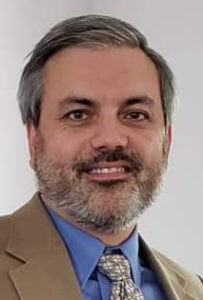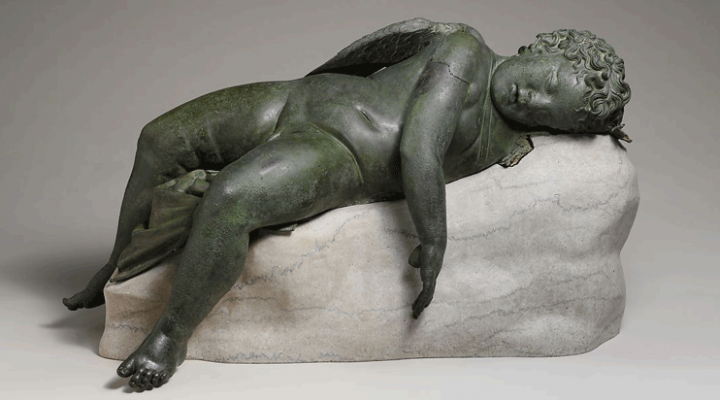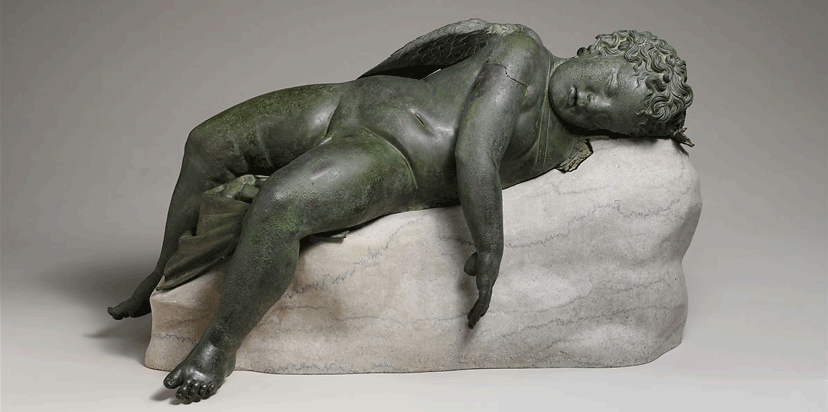Back in 1496, the young aspiring Italian artist Michelangelo recreated a sculpture of the sleeping Eros. The forgery depicted the Greek god of passionate love laying on his side in deep slumber.

Patrick Wilson
Collectors of his day highly sought these small statues of the god of love, so Michelangelo used some kind of acidic soil to alter the appearance of the marble, making it look aged. Then, he sold it to a powerful cardinal in Rome named Raffaele Riario. The cardinal later discovered the artwork was a forgery, but he so admired the up-and-coming artist’s talent that he hired Michelangelo to create two additional sculptures for him.
Today, there are many additional techniques and more enhanced technology to differentiate a fake from the “real McCoy.” The trained eye of a professional can detect the use of more modern tools, evaluate pigment alterations through fluorescence, use X-ray diffraction to identify the paint or other materials, analyze the signature, or even consider the framing or other objects used to encase the artwork. In the art world, it is very difficult to pull off a forgery today.
“In the church, we remain inauthentic all the time.”
Yet, in the church, we remain inauthentic all the time. Having a façade is not just commonplace among those who are new or unacquainted with life in a religious setting; it is very common (perhaps even more prevalent) among long-time members and even clergy to personify ourselves as “strait-laced” righteous saints. Younger generations see through this lack of authenticity and identify it as a major deterrent to continued participation in organized religion.
Meanwhile, some churches are perpetuating the atmosphere of “putting on your Sunday best.” Not just dressing up but masquerading our true inner turmoil at church also leaves our spirituality shallow and hollow of relational depth.
In an effort to preserve a false sense of security, we darken the doors of the church but remain in the darkness of our own uncertainties, brokenness and frailties. Hiding behind these insecurities, we create an echo chamber where growth is stifled and the gospel becomes stale.
Oftentimes, we speak of false teachers and anti-Christ figures as those who preach, teach or live something contradictory to the good news of Jesus, but we fail to see the inconsistencies in ourselves. Perhaps there is nothing more antithetical to the gospel than inauthenticity of the reality of our messy lives, superfluously sugar-coated with the ritual and trite patterns of our Sunday vestments and practices.
All this came to me through the poignant question of a friend a few years ago. I was wrestling at the time about whether I should stay and continue serving in the church where I was pastor or resign without another position. My friend asked, “Can you be your authentic self where you are?”
It was then that the decision no longer rested on what happened at the church, with the leadership or among the members of the congregation. Now, the decision was internal; it was about what was going on inside of me. I was being honest and transparent about what God was doing in my life, but I was having difficulty navigating the great philosophical and theological diversity in the church. Was it sustainable for me to continue to try to manage my own spiritual pilgrimage within the complexities of the ideologies of the church I served?
As I decided to step away, I did not have a lot of clarity about what the future held but what I did know is I was freer than ever — free to be me. Since that time, I’ve been extremely fortunate — providentially surrounded by other like-minded and intentional believers to start a new and very different type of community of faith. In this new chapter, I am truly striving to peel back the layers of what is happening inside me and to be authentic and raw in the expression of my faith — publicly as well as privately.
I’m convinced now more than ever that authenticity is the key to personal spiritual growth and collaborative, missional living. I earnestly believe the future of the church rests on pastors, staff and church leaders modeling authenticity in these three ways:
Uncertainty: Pastors oftentimes fall into the trap of trying always to have the correct answer. We are expected to have a clear vision for the church. We must be able to give accurate interpretation to Scripture. We should be able to provide counsel to anyone who comes into our office and asks for assistance. We ought to be able to manage a broad range of responsibilities from finances and marketing to leading staff and negotiating conflict.
Yet this is a forgery. I have found great liberty in oftentimes saying, “I don’t know.”
I am uncertain how the universe came into existence, and I have very little confidence in my hypotheses on how the future will unfold. At best, I have theories about how biblical passages should be interpreted, let alone which manuscripts are the most authentic. I remain in a fog about what is best for the long-term goals of our church and continue to find myself pivoting often based upon developmental change.
I just don’t know, and that is authentic and liberating.
Brokenness: Pastors oftentimes fall into the trap of trying to be and to look righteous. Addressing the great ills of society and expounding on the mandates of Scripture, we speak in generalities about “sin” and often use illustrations of others to get our point across. Our congregants place us up on the spiritual pedestal, and while we are quick to denounce such lofty positioning, we fail to step down from the podium.
“Our congregants place us up on the spiritual pedestal, and while we are quick to denounce such lofty positioning, we fail to step down from the podium.”
We live in the fear that our job is jeopardized, so we remain tightlipped and unwilling to share about the struggles, pains, questions and trials of our own lives.
Yet, this is forgery. I have found great liberty in saying, “I am journeying.”
I fall down; I mess up. My shortcomings garner more of my attention, leaving little room to see the weaknesses in others. Most days, I do the best I can with what I have but the tools at my disposal are, at times, obsolete, unsharpened or unavailable.
I share about the deconstruction of my faith with my fellow sojourners. Sometimes we laugh; other times, we cry. I am no different than any other person striving to walk alongside Jesus and grow through the adventure. I am on a journey, and that is authentic and liberating.
Frailty: Pastors oftentimes fall into the trap of limitless expectations. What our congregants do not put on us, we put on ourselves. We should be at every church service, event and activity at or away from the church campus. In addition, we need to check on every absent church member and visit the sick in the hospital regardless of whether we know of their illness or not. We should be accessible at all times, day or night. We ought always to respond in the best way, communicate effectively and be whole — physically, mentally, emotionally, spiritually and socially.
Yet, this is forgery. I have found great liberty in saying, “I am human.”
I have ups and downs, highs and lows. I go through periods of frustration and disappointment, heartache and depression. I don’t always handle things well. I need time to unplug and recharge. I need a life that is not exclusively built around the church calendar. I benefit from therapy, counseling and life-coaching too.
I am human, and that is authentic and liberating.
When I look at the Bible through the lens of authenticity, the stories of Scripture burst with a full array of color. I feel Abram’s fear of disclosing the identity of Sarai (Genesis 12:13). I affirm the prophetic utterance that God’s thoughts and ways are not my own (Isaiah 55:8). I resonate with the father who brought his demon-possessed son to Jesus and claimed, “I do believe. Help me overcome my unbelief” (Mark 9:24).
I place myself on the shore of Galilee as Peter cannot authentically acknowledge that he has agape love for Jesus after his recent denial. Nonetheless, the transparent unmasking becomes the invitation to know Jesus in the deepest possible way. As Jesus validates Peter, he meets his apprentice where he is — in the hurt of being asked a third time, “Do you love me?” (John 21:17). It is in this raw state of uncertainty, brokenness and frailty that the gospel comes alive.
“Perhaps if we ended the charade, we might experience the kingdom in a new and refreshing way.”
Perhaps if we ended the charade, we might experience the kingdom in a new and refreshing way. Perhaps if we took off the mask, we would see each other as we all truly are. Perhaps in the risk of being authentic, we will find the beauty of what it means to love and to be loved.
If there is any hope for the future of the Christian faith in America (and I believe there is), it is in the enthusiastic fervor of the younger generations to love well. Loving well must begin with a sacred and safe space for transparency — real and raw, messy and chaotic, emotional and irrational authenticity.
The church was built on the authentic identity of Jesus as the Messiah amidst the incomplete and inaccurate presuppositions of a warrior king. Jesus chose not to conform to the hopes of an earthly empire but strived for something greater — a kingdom within us (Luke 17:21).
Jesus remained authentic to his identity, his struggles and his calling. As his followers, we must do the same. Authenticity is essential to relationships, and relationships are essential to the kingdom of God.
Patrick Wilson has served as a pastor for 25 years in Dallas and Austin, Texas, and most recently in in Rolla, Mo., where he now leads a new community of faith, CrossRoads. He is a graduate of Baylor University, earned two master’s degrees at Southwestern Baptist Theological Seminary and a doctor of ministry degree from Logsdon Seminary.


